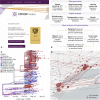Real-time public health communication of local SARS-CoV-2 genomic epidemiology
- PMID: 32822393
- PMCID: PMC7467297
- DOI: 10.1371/journal.pbio.3000869
Real-time public health communication of local SARS-CoV-2 genomic epidemiology
Abstract
Genomic epidemiology can provide a unique, real-time understanding of SARS-CoV-2 transmission patterns. Yet the potential for genomic analyses to guide local policy and community-based behavioral decisions is limited because they are often oriented towards specially trained scientists and conducted on a national or global scale. Here, we propose a new paradigm: Phylogenetic analyses performed on a local level (municipal, county, or state), with results communicated in a clear, timely, and actionable manner to strengthen public health responses. We believe that presenting results rapidly, and tailored to a non-expert audience, can serve as a template for effective public health response to COVID-19 and other emerging viral diseases.
Conflict of interest statement
The authors have declared that no competing interests exist.
Figures

References
Publication types
MeSH terms
Grants and funding
LinkOut - more resources
Full Text Sources
Miscellaneous

